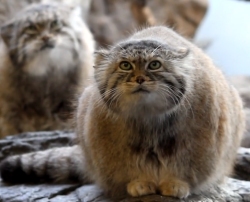Pallas cat

Should you ever travel to some of the wilder and more remote parts of central Asia, you might see what appears to be a small bearded monkey peering at you over the rocks. Thatís the Pallas cat, or Manul as it is generally known to the locals.
The Pallas cat is a remarkable animal in many ways. Firstly, it is a very old breed - it separated from its nearest relative, the leopard cat some 5.2 million years ago, and the species has not changed very much since. Thereís been no need to do so, for the Pallas cat is perfectly evolved for the harsh but beautiful environment in which it dwells.
The Pallas cat is about the size of a domestic cat, but the relatively short legs and chunky body build make it look larger. The body bulk is because this cat is extremely muscular, so comparing the Pallas with a domestic cat is like comparing an average citizen with an all-in wrestler. Now add a very thick, coarse pelt and you have a wrestler in a bulky fur coat - the result may look ungainly but is in fact surprisingly fast and agile - and a mean fighter as well.
The compact body is one reason why a Pallas cat may be mistaken for a monkey. Another is the short tufty ears which are set far apart on the skull. These ears are what give the 'official' taxonomic name to the species which is Otocolobus Manul. 'Oto' is a Greek word for 'ear' and 'kolobus' means 'ugly'. (Pallas cats are probably not that impressed with the shape of human ears either. The 'Pallas' name comes from Peter Simon Pallas, the German naturalist who first described the cats in 1776. The Otocolobus bit is courtesy of Nikolai Severtzov a Russian naturalist who added this in 1858. History does not record the aesthetic quality of his ears.)
The faces of Pallas cats are much flatter than average - closer to a Persian than, say, a bobcat. The flattening of the face means that the Pallas cat has a shorter jaw with fewer teeth - the first pair of upper premolars are absent. This skull shape puts the Pallas in the genus Prionailurus (a genus of four species of small, spotted wild cats found in Asia: Leopard cat, Rusty-spotted cat, Fishing cat and Flat-headed cat) within the tribe felini. But the white chin, cheeks and beard combine with the flat face so that at certain angles the cat does indeed look very monkey-like. As a final touch, the Pallas cat has an attribute unique among cats. In bright light its eyes do not contract into slits as do the eyes of every other cat on earth. Instead the pupils shrink into circular dots - just as the pupils of hominids do.
Once one gets past the startling aspects of its appearance, it becomes clear that the Pallas cat is in fact a rather handsome beast. The thick, greyish-brown fur has dark rings on the legs and tail and dappled black markings on the forehead. The wide, amber eyes give the cat a rather kittenish appearance. Unlike kittens though, Pallas cats are shy and very antisocial animals, impossible to domesticate. In the wild they live alone and prefer environments that most humans would consider hostile - high scrubland and mountain regions between sub-alpine and montane (the really high bits). In fact Pallas cats can be found at altitudes of up to five kilometres above sea level.
(Pallas cats at the Prospect Park Zoo)
The thick fur helps the cats to cope with the harsh winters in this environment, but the fur is the reason why the Pallas cat is listed as a 'near-threatened' species. The warmth of the pelt, and the attractive 'frosted' appearance caused by the white tips of the hair have made Pallas cat coats attractive to humans living nearby. With the coming of the rifle so many cats were killed that hunting the species is now banned in most countries.
Humans are deadly to the Pallas cat in other ways as well. In the wild, Pallas cats have a solitary existence, only meeting other adults to mate (and the female is in oestrus for just two days, so any encounters have to be brief). Consequently the Pallas has a miserably weak immune system, because it usually doesn't meet much that can infect it. So Pallas cats in zoos lose most of their kittens to one infection or another. Adults have lived up to 11 years in captivity. It is not known for how long they live in the wild.
Wild Pallas cats live on virtually anything they can catch. Small mammals including desert rats, pikes and voles feature prominently in their diet, along with small birds and any young marmots with inattentive parents. Because its build makes it an unlikely sprinter, the Pallas cat hunts from ambush. The pelt blends in well with the rocky scenery, and most victims never see their peril until it is too late.
(Hunting Pallas cat in its native environment)
The harsh rocky environment also makes for a short breeding season, since there is only a short window of relatively benign conditions in which a kitten can survive. Kittens mature quickly. Within two months their short fuzzy pelts have been exchanged for an adult coat and after four months they are out hunting their own food. Within six months the kitten is adult-sized and ready for independence.
There are three known subspecies of Pallas cats:
- Otocolobus manul manul, originally described by Pallas in 1776, inhabits the northern part of the range.
- Otocolobus manul nigripecta was described by Hodgson in 1842. This subspecies occupies the area of Tibet and Indian Kashmir.
- Otocolobus manul ferruginea, described by Ognev in 1928. Those cats can be found predominantly in the south-western part of the range.

